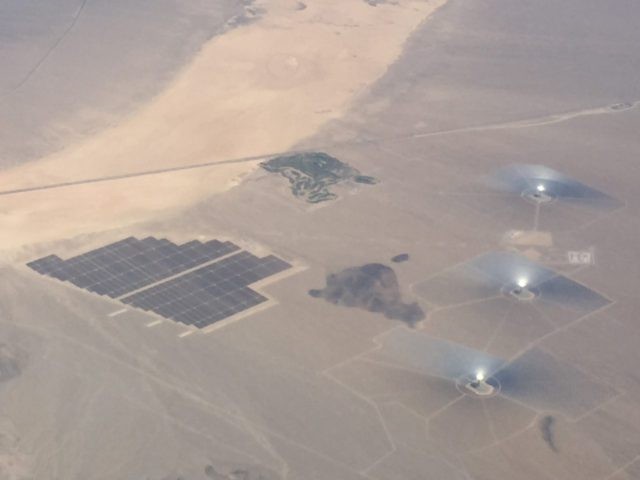The only good news from California’s wildly subsidized Ivanpah Solar Electric Generating System is that it has reduced its rate of incinerating wild birds from 10 to 2 per hour.
Ivanpah Solar Electric Generating System opened in California’s Mojave Desert in February 2014 as the world’s largest solar power plant. With 350,000 moveable mirrors covering 5 square miles, light is reflected into concentrated energy beams onto three 40-story towers to boil water and create electricity.
The 400-megawatt facility, a joint-venture between NRG Energy, Google and BrightSource Energy cost $2.2 billion to build, but was subsidized with an Obama administration $1.6 billion federal loan guarantee.
Under SB 871, Northern California’s PG&E utility is forced to pay a premium price of $57 a megawatt hour for solar power, versus $35 a megawatt hour for electricity produced from natural gas. But in an extreme example of how the economic idiocracy of “sustainable energy” and crony capitalism play together, PG&E has paid Ivanpah $200 a megawatt hour during the summer and $135 a megawatt hour during the rest of the year.
The plant also received huge California subsidies that included a 30 percent Investment Tax Credit for buying solar capital assets, and a guarantee that utilities will buy all Ivanpah’s electrical generation, despite the time of day or level of system demand.
Ivanpah is not efficient at producing electrical power, but it turned out to be first-in-class at slaughtering about 28,000 wild birds in its first year. With the facility only operating an average of about 8 hours per day, Ivanpah was killing about 10 birds an hour. Workmen referred to birds that flew through the “death-ray” light beams as “streamers,” because they ignited in midair like a comets, and then plummeted to the ground trailing smoke.
The Audubon Society of California pulled together several conservation organizations and demanded the plant close for violating the Migratory Bird Treaty Act. Audubon claimed that bird losses from Ivanpah were multiples worse than the Altamont Winds Inc. turbines in Northern California, which killed at least 67 golden eagles, 80 American kestrels, 57 burrowing owls, and 172 red-tailed hawks over a recent 10-year period.
David Knox, a spokesman for NRG Energy Inc., told the Los Angeles Times that Ivanpah is trying to be pro-active in testing an “ever-changing combination of tactics to minimize bird deaths and injuries since it began sending power to the grid in 2014.” He added, “If there’s a silver bullet out there, maybe we’ll find it.”
The Ivanpah plant claims to have redirected the death rays from migratory bird paths; replaced flood lights with LED bulbs that attract fewer insects that the birds feed on; attached anti-perching spikes to the frames of the three towers; added devices that make loud recorded broadcasts; added high-pitched shrieking noises; and fitted each tower with machines emitting nonlethal avian respiratory irritants used by farmers to protect crops.
But when pressed by the Times, Knox acknowledged, the results have been “modest.” According to federal biologists from the Obama administration, the bird kill rate is down to about 6,000 per year, or a bit over two an hour.
On top of the smoky mess is the reality that solar power, by definition, is an intermittent energy source that is unavailable every night and affected by overcast skies. Engineers refer to electrical power streams that are intermittent as a “dirty” resource, because the utility’s infrastructure must include another 100 percent fossil-fuel power back-up.

COMMENTS
Please let us know if you're having issues with commenting.